Many people use the terms "dehydrated" and "freeze-dried" interchangeably, but they refer to different food preservation methods. This guide will help you understand the key differences between these two processes.
The Dehydration Process
Dehydration has been a method of food preservation for thousands of years, dating back to at least 12,000 BC.1 Historically, the Romans and Middle Easterners dried fruits and vegetables using fire in “still houses.” Modern dehydration involves machines that circulate hot, dry air to remove moisture from the food without cooking it. The air is then dried to continue removing water. Dehydrated food typically becomes withered and harder.

The Freeze-Drying Process
Freeze-drying is a more modern preservation technique, originally developed during World War II to preserve blood plasma, medicine, and food. Today, it requires high-tech machinery, although home units like the Harvest Right Freeze-Dryer are now available. The process involves placing food on racks inside a vacuum chamber, lowering the temperature below freezing, and then slowly raising it. This turns water in the food from a solid to a gaseous state, preserving the food’s structure and nutritional value.
The Main Differences
Moisture Content: Dehydration removes about 90-95% of moisture, while freeze-drying removes 98-99%. Dehydrated foods typically have a 10% moisture level, whereas professionally dehydrated foods have even less, increasing shelf life.
Shelf Life: Dehydrated products like dried fruits and vegetables have a shelf life of about 15-20 years, with some items like honey and salt lasting 30 years or more.5 Freeze-dried foods generally have a shelf life of 25-30 years.6 Ideally, store all food at temperatures of 60°F or lower.
Nutritional Content: Freeze-dried foods retain most vitamins and minerals but can lack some vitamins, like Vitamin C, which degrades quickly. Dehydrated foods can lose more vitamins, including Vitamins A and C, and other nutrients during the process.7 Dehydrated foods retain fiber and iron but can have reduced nutritional value compared to freeze-dried foods.
Appearance & Composition: Dehydrated foods often appear withered, like banana chips, whereas freeze-dried foods retain more of their original shape and texture. Freeze-dried foods are lighter and easier to store compared to dehydrated foods.
Cooking: Dehydrated foods usually require cooking and seasoning, which can take from 15 minutes to several hours. In contrast, freeze-dried foods only need water to rehydrate and are ready in less than 5 minutes.
Cost: Generally, dehydrated foods are less expensive than freeze-dried options. If you’re on a budget, dehydrated foods can be a more economical choice.
The Main Similarities
Packaging: Both dehydrated and freeze-dried foods are often packaged in cans that are filled to capacity, sealed with an oxygen absorber, and double-enameled to extend shelf life.
Storage Requirements: Both types of foods have similar storage needs, typically in cans or buckets of the same size.
Insurance for Your Family: Both dehydrated and freeze-dried foods provide insurance against natural disasters, power outages, and emergencies. Explore our complete listings of food storage and water storage items.










